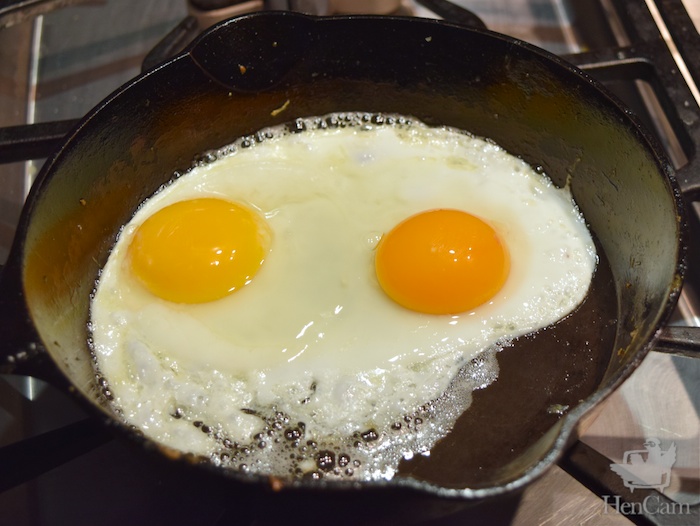One of the things that we small flock keepers tout about our fresh eggs is the vibrant color of the yolks. Supermarket eggs are pale, but look at these! we say, pointing to the upstanding orange centers.
Of course, there’s always more to the story. Here are two eggs.
One is pale. One is deeply colorful. Both came from my flock.
The egg on the left was laid this week by Twiggy. The one on the right was also laid by Twiggy, but that one was laid ten days ago, when she had been gorging on pumpkin. Both were delicious.
Many fruits and vegetables contain carotenoids, which are orange pigments that pass right through to the yolk. They’re also nutrient powerhouses. So far, research has shown that it is best to get carotenoids from your diet, not from pills. Egg yolks are a good source! The brighter the orange in the yolk, the more nutritious those eggs are. Maybe.
Industrial egg producers have caught on that consumers want dark yellow yolks, which they equate with the health of the birds and the nutrient quality of the eggs. However, those producers do not free-range their pullets and feed them pumpkins. They use supplements. I read about one source here. This is part of the article:
Whenever the market demands for more pigmented egg yolks the oxycarotenoids concentration in layer hens’ feed can be increased. Oxycarotenoids present in Rubrivivax gelatinosus biomass grown in industrial wastewater have already proven their ability on enhancing yolk colour.
Only slightly more appetizing is the industry’s use of paprika and marigold to color egg yolks. I feed my hens marigolds – right before the first frost I pull the plants and feed them to the hens, roots, flowers, leaves, stems and all. That’s far different than feeding extracts. But now that we’ve had several hard frosts and even snow, there’s not much growing and colorful for the hens to forage. So, I feed alfalfa. After writing this post, I think I’ll splurge on another couple of pumpkins for the girls, too!


My girls are funny, they won’t eat pumpkin but love sweet potatoes and butternut squash! Of course I cook the sweet potatoe slighty otherwise they wont eat it because theres no seeds. It seems the my girls will only eat what the top hen will eat…it’s crazy!
There’s some research showing that chickens develop some food preferences during incubation – depending on the surround aromas.
I had no idea commercial hens were fed YUCK to enhance their yolk color! Shoulda known better; glad I don’t ever buy commercial eggs.
This is why I read the trade journals – they tout things that they do that they’d never tell the consuming public.
I’ve been giving my hens pumpkins from our garden, but they have LOTS of seeds in them. I’ve been pulling out most of the seeds because I feared impacted crops. I know the girls love them, and I don’t want to deprive them of something good for them. Should I be worried about this or just let them have the entire pumpkin and not pull out the seeds?
The seeds and pulp are the best part as far as my girls are concerned – they love them! On the other hand, they have very little interest in pumpkin flesh. They’ve never had a problem with the seeds and pulp and they always have access to free choice grit.
The seeds likely have a worming effect, so let them eat them. They won’t get impacted crops if they’re otherwise healthy and have a wide variety of foodstuffs to eat.
Thank you both. That’s great news for my chickies and they will be very happy! Of course, I’ve also kept some for planting next year. :)
“Biomass grown in industrial waste water”? Eeeeeeeek!
“Biomass grown in industrial waste water” – Industrial these days includes factory farms.
This might mean algae grown in manure tea.
Which is a different story than grown in, say, dye effluent, or chrome process wastewater…
Which is not to say I support this as a sort of carotene.
We need to find some sustainable round-robin processes that allow large production facilities (not necessarily the factory footprint) and controls/uses the by products.
If we grew the soil instead of ‘petrolizing’ it in large agriculture, there would be a market for all the weird by-products they instead sell to the dog food producers (like the floor sweepings from a chicken factory – shit, bedding, feathers – right now all of that is allowable in pet food as a by-product)
As compost – those by products could be composted and then added to the soil to feed it – as with eggs, the better the feed, the better the product. … man, I am a bit disorganized this morning…
And on another tangent, we are just barely beginning to understand how our own gut bacteria biome works to keep us healthy, all the shouting by ‘industry’ that a petrol grown vegetable is as nutritious as a biome grown one has yet to be proven, only because we have no idea what is missing. Our science hasn’t caught up yet.
I can remember when doctors advocated formula over natural nursing, because it was more nutritious, and didn’t have a bunch of stuff that wasn’t ‘needed’ – turns out that ‘unneeded’ stuff feeds the bacteria biome, which in turn feeds the host body.
There is so much we just don’t know.
Okay. Enough of my rambling. Thank you for reading!
If a blogpost has made you think and rant, I’ve done my job :)
Go, Jenn!
Happy Birthday Terry!!!!
Thank you! 55 was a very, very good year.
Lucky for us to have you in our lives for another year….A very Happy Birthday to you Terry!!
Terry, even Twiggy’s “pale” egg is much more colourful than many of the commercial eggs I have seen before I switched to buying eggs from locally raised chickens.
And what stands out to me with Twiggy’s eggs are those nice firm whites. For me that is one of many reasons a store bought egg turns me off.
Gotta’ say, it’s been nice not to have to buy eggs the last several months, and the flavor is far superior. I also have to say thanks to you, Terry, for handing out the advice you do: saved me some worry. I do have one egg question though: is there anything I need to know about fertile eggs? Except for a few destined for the incubator occasionally, the daily collections are promptly placed in the fridge (to warm up, today: it was 20 degrees for a high here). Any storage or usage problems that may happen with fertile eggs?
Kept chilled, the embryos should not develop. Still, I’d not keep them around for weeks.